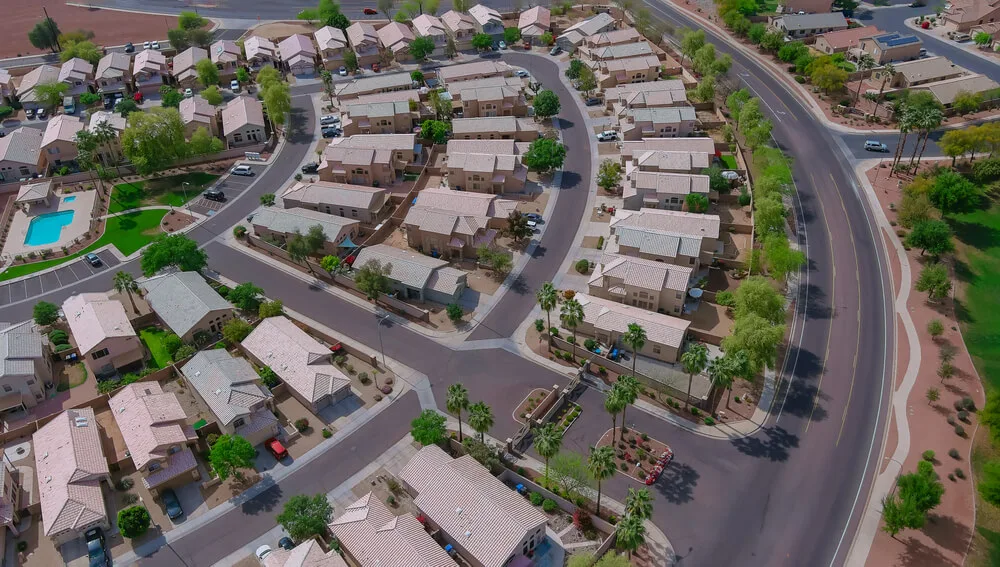
(Shutterstock Photo)
“We have about two weeks worth of inventory. If nothing would be added to the listing in two weeks, everything would be gone.”
Ken Fomby was looking for a three-bedroom, two-bathroom house in Phoenix to live in with his teenage daughter and their dogs. His budget was around $300,000. He had a stable income, good credit, and was prequalified by his lender.
But three to four months after he started looking in March, he gave up—the competition in the local housing market was too intense.
“Right now the market is just crazy,” Fomby told The Copper Courier. “You’re lucky if you can find a house to go look at that hasn’t gotten swooped up before you can even get to it, or if there’s not already 50 offers on it.”
Housing experts confirm the real estate market in the Valley is highly unusual at the moment, with people paying way above asking prices, paying cash, and waiving inspections and appraisals.
Patricia Duarte, CEO and president of Trellis, said people with lower incomes are being boxed out of owning a home. Trellis is a Phoenix-based nonprofit that helps people navigate the home-buying process, and they worked with Fomby during his search.
“The housing market currently is really strange and discouraging to many, especially those on the entry-level home-ownership pricing,” Duarte said.
Low Supply Driving Up Demand
The problem begins with the area’s low supply of housing, Duarte said.
“We have about two weeks worth of inventory,” she said. “If nothing would be added to the listing in two weeks, everything would be gone.”
Katie Gentry, a policy analyst with the Morrison Institute of Public Policy at Arizona State University, also cited a lack of housing.
“Following the Great Recession in 2007, we were not building at the capacity needed to accommodate our population as is, let alone the growth of population that we’ve seen in Arizona,” she told The Copper Courier. “So right now we’re at the issue of having a significant lack of supply comparatively to demand and our population is continuing to grow exponentially.”
And the lack of supply isn’t just due to a lack of properties being built—it also has to do with investors buying up homes and renting them out.
“During the Great Recession, many homes that used to be owner-occupied became rentals,” Duarte said. “If those homes would become available again for ownership, it would solve part of the problem. But some investors who learned, they figured out how to make money off of single-family rentals, big portfolios across Arizona. I believe that’s a contributing factor because it’s inventory that people could own, but it’s rentals.”
But Gentry said this trend has been happening for a while and isn’t necessarily increasing right now.
“A study back to 2018 showed that about 20% of our home purchases were investors which is on the higher end relatively speaking across the US,” she said. “Right now in the market I wouldn’t say there are more investors than there have been in the past.”
What Does Arizona Need to Do to Increase Supply?
Gentry said something holding developers back from building more affordable housing is likely the high cost.
“Lumber is expensive and labor is expensive and land is expensive, and so until those three things kind of come into a reasonable cost, you’re going to continue to see this cost go up,” she said.
And by that token, she said, developers and municipalities should be working together to find more affordable ways to build.
Duarte pointed out that building homes that are affordable doesn’t bring in as much money as luxury properties would.
RELATED: Coronavirus Is Exposing Why the Affordable Housing Crisis Is Also a Healthcare Crisis
“Developers will go the easy path and the path that’s going to get them more money,” she said. “Entry-level housing doesn’t … leave a big profit margin, so I think at the end of the day, it’s the money factor.”
Duarte said new product types and building materials need to be explored. Another potential solution, she said, is the use of land trusts.
“Many have realized that we can keep homes affordable for a much longer time if the owner saves money by not paying for the land,” she said. “They just own the structure and if they decide to move and sell, then that structure can be sold, but that land stays in a land trust, keeping that affordability and opening that home to somebody else that is low-to-moderate-income.”
It’s Not Just the Californians
Both Gentry and Duarte said they have heard people blame the competition in the housing market on a large number of Californians moving to Arizona. But it’s not that simple, they said—Arizona is taking in people from all over.
“We do have a population coming from California … but the data actually shows that Californians are moving to other places besides Arizona, for example, Vegas and Texas,” Gentry said. “But that being said, people are not just moving from California. We have immigration having from all over the US into Arizona.”
The 2020 Census showed that Arizona’s population grew by 11.9% since 2010, making it the ninth state in the US for fastest growth.
Duarte added that it’s not just out-of-state people who are stepping out of the traditional home-buying process.
“I know some Arizona locals, born and raised in Arizona folks, that are looking and they have made offers that they have been willing to pay above appraisal,” she said, “so people are getting desperate.”
Duarte said while the current market may be discouraging, people shouldn’t give up on the idea of one day owning a home.
“If they’re not finding something right now, don’t stop saving,” she said. “Hopefully, there will be a time where you’ll be able to buy.”
Federal Funding May Be on the Way
The struggle to find housing isn’t just a problem in Arizona—the US has been dealing with a shortage of affordable homes long before the pandemic wiped out the incomes of millions of people.
To try to tackle the issue, President Joe Biden said during his campaign he wanted to invest $640 billion in affordable housing over 10 years.
His administration’s American Jobs Plan, a package devoted to improving infrastructure in the US, would have allocated $318 billion for housing investments.
But the plan received pushback from Republicans, and Biden worked with a bipartisan group of senators to negotiate a new plan that leaves out affordable housing.
However, Biden has said he will not sign this new plan if Congress doesn’t deliver a second package that includes housing.
“A lot of our housing pieces didn’t get passed. We’re coming back at it though,” Biden said during a June 24 speech. “We’re coming back at it. We’re going to make the case.”
READ MORE: Leaders of Arizona’s Largest Cities are Calling for Bold Infrastructure Action
Politics

Trump says he would allow red states to track pregnancies, prosecute abortion ban violators
In an interview published by Time magazine this week, former president Donald Trump detailed his plans for a potential second term and said he would...

VIDEO: Meet William Claude Jones, one of the men who helped pass Arizona’s 1864 abortion ban
@coppercourier Meet William Claude Jones, one of the men who helped pass Arizona's 1864 abortion ban. Source: Washington Post #ReproRights...
Local News

How the University of Arizona could help discover extraterrestrial life
What you need to know about the Giant Magellan Telescope and how the University of Arizona is playing a major role in building it. Scientists are...

Silver savings: Where to find the best senior discounts in Phoenix
Here's where you can find the best senior discounts in the Phoenix area. Click! Pop! Crack! Is that thunder from the monsoon or the sound of your...





